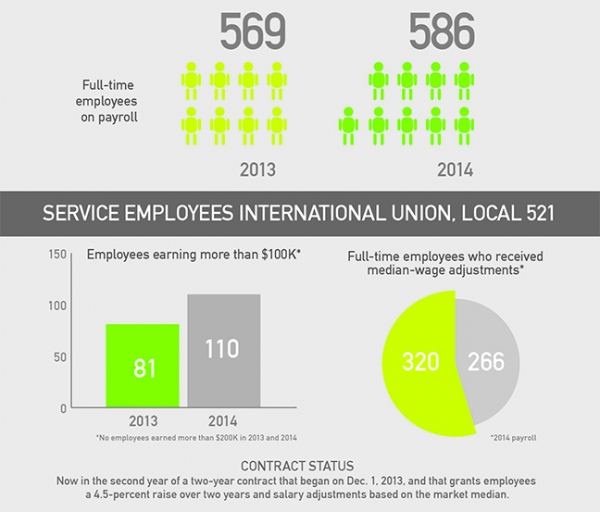• To read about what's driving Palo Alto's growing payroll, click here.
Click on the links below to read about each group's employee compensation:
• Management and Professional group
• Police and firefighters union
When it comes to employee compensation, the city's lowest earners usually serve as the canaries in the coal mine. The roughly 580 employees represented by the Service Employees International Union, Local 521, are first to feel the pain when the city's revenue picture clouds over. When the skies clear, they are the first to feel the sunlight.
In 2009, the union faced a crisis. The City Council and City Manager James Keene had launched an effort to reform workers' benefits and require employees to contribute to their pensions and health care, citing the economic downturn and the need to make "structural" changes in staffing to cut costs. Like other labor groups, the SEIU had already agreed not to seek wage increases. Agreeing to permanent cuts to benefits proved a tougher sell.
With tensions between workers and management on the rise, hundreds of SEIU workers marched through downtown with brooms and megaphones, gathered for a spirited rally in front of City Hall and held a one-day strike (described by union officials as a "self-imposed furlough"). With negotiations at an impasse, the council imposed the reforms unilaterally and the union acquiesced.
The SEIU workers' wages remained largely flat for the next few years. In 2012, with the economy on the mend, the council approved a cost-of-living adjustment of 1.68 percent and agreed to institute training programs for SEIU workers in specialized fields. Yet the new two-year agreement that the union ratified came with a steep cost: It required employees to pay a "full share" of their pension contributions to CalPERS, the state public-employees pension fund, which comprised between 7 and 8 percent of their salaries. It also upped their health care contributions from about 6 percent of the premium to about 10 percent.
By the time 2014 came around, austerity was making way for prosperity. The council was on its way to approving a new infrastructure plan that would include a bike bridge over U.S. Highway 101, a downtown garage, a police headquarters and a rebuilt fire station.
Yet for roughly 100 SEIU employees who packed into City Hall that January, the revenue boom only signaled another crisis. Various employees from Public Works and Utilities warned the council that Palo Alto was struggling to attract and retain talent because of inadequate compensation. Pete Quiros, a gas worker, said the city's "best and brightest" workers were departing to PG&E for higher salaries. Jesus Cruz said out of the department's six electric operators, he's the only one left.
The city, despite an initial impasse in negotiations, agreed with the concern. That March, the union won a contract by which its members received their first significant raise since 2008. The contract, approved unanimously by the council, gave every worker a 4.5 percent raise spread out over the two years: 2 percent in the first year of the contract and 2.5 percent in the second.
More significantly, the contract increased the salaries of about 320 employees in 89 positions so that they would more closely match the market average, as determined by a benchmark study of neighboring jurisdictions. While in some cases the raise was less than 2 percent, in many cases it was 10 percent or more.
Keene, echoing the workers, said that adjusting the salaries up to the market median was driven by the city's need "to really be competitive and attract and retain the kind of folks that Palo Alto citizens demand."
"We're placing ourselves at the median of the market, but I don't think we're expecting median-of-market performance," Keene said. "I really think our community and the council and me too — we all expect top-of-the-market performance. Yet we're not saying we're going to position ourselves at the top of the market."
The adjustments were particularly significant in some of the most specialized positions in Utilities and Public Works, where the recruiting challenges were most acute. In the category of "utility locator," 13 positions received upward salary adjustments of 14.6 percent over the two-year term, according to the union contract. Seven positions in the "programmer analyst" category received pay bumps of 14.3 percent. In the "linesperson" category, eight positions saw salary increases of 12.1 percent and one — the utilities system operator — saw a pay bump of 19.5 percent over the course of two years.
As a result, some salaries have shot up by dozens of thousands of dollars. The two highest wage earners in the SEIU group last year were both SCADA (Supervisory Control and Data Acquisition) technologists in the Utilities Department. They earned $178,931 and $177,901 in 2014, respectively. In 2013, their salaries were $118,230 and $105,933, respectively. Cruz, a 20-year veteran of the Utilities Department, saw his base salary climb from $91,064 in fiscal year 2013 to $102,225 in 2014. His total compensation, which included overtime pay, went from $125,669 to $166,000.
Altogether, 110 employees represented by SEIU, Local 521, received salaries of more than $100,000 in 2014, compared to just 81 in 2013. The number is almost certain to go up further in 2015, thanks to the universal 2.5 percent raise that kicked in on Dec. 1, 2014.
The city did extract one concession from the union. Under the new contract, the city's contributions toward worker's health care are shifted from a percentage of the premium to a flat rate — a move aimed to bring some stability to the city's rising health care expenditures.
Like every recent employee contract, the city's agreement with SEIU was approved quickly and unanimously by the council. Keene said it "offers a fair and balanced deal that seeks to ensure we can retain our excellent employees ... while also controlling health care costs in the future."
Margaret Adkins, chapter chair of SEIU, Local 521, called the contract a "step in the right direction."
"The contract provides city workers with some immediate relief, but I doubt the wage requirements and cost-of-living adjustments will be enough to reverse Palo Alto's current staffing and retention crisis," Adkins said in a statement.





Comments
Meadow Park
on Apr 24, 2015 at 9:21 am
on Apr 24, 2015 at 9:21 am
If Cruz is the only 'electric operator' left out of six, I can accept he would have to do a lot of overtime. How is it possible they cannot hire more operators at that salary?
Am I understanding the SCADA Technologist description at Web Link ? They do not require even a Bachelor's degree for that type of pay?
Lastly does the city even have 17 Utility Locators?